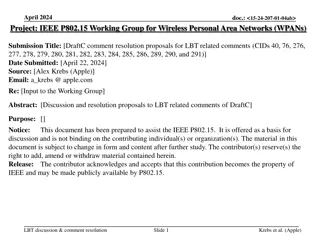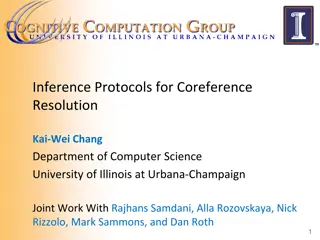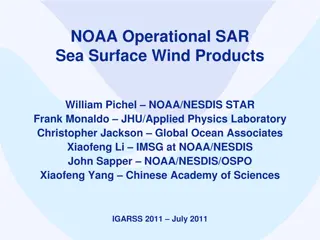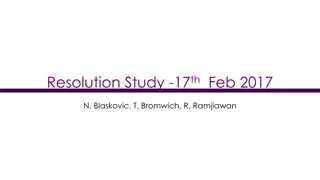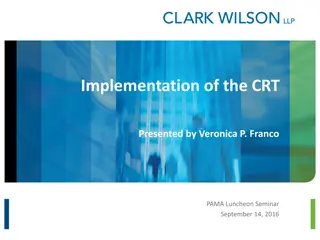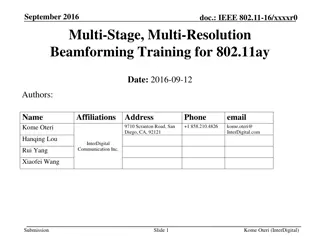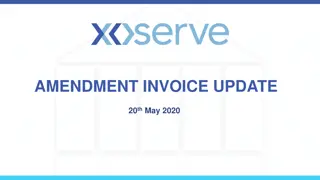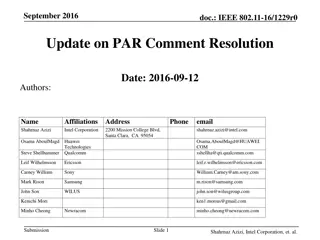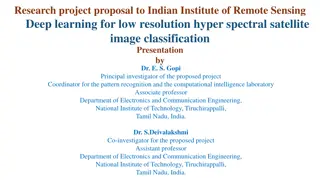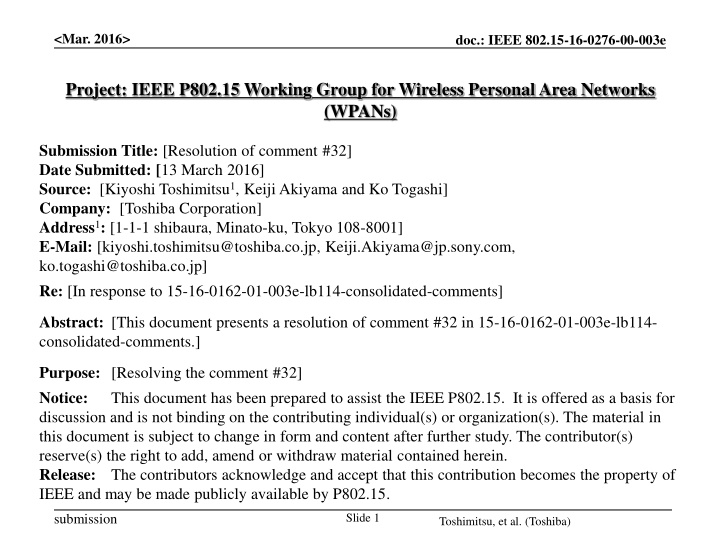
IEEE 802.15-16-0276-00-003e Resolution of Comment #32
This document presents a resolution of Comment #32 submitted to the IEEE P802.15 Working Group for Wireless Personal Area Networks (WPANs) in March 2016. It addresses the need for specifying parameters and Service Access Points (SAPs) in the context of data transmission/reception. Additionally, it provides resolutions for MLME changes and primitive parameters related to PNPP creation.
Download Presentation

Please find below an Image/Link to download the presentation.
The content on the website is provided AS IS for your information and personal use only. It may not be sold, licensed, or shared on other websites without obtaining consent from the author. If you encounter any issues during the download, it is possible that the publisher has removed the file from their server.
You are allowed to download the files provided on this website for personal or commercial use, subject to the condition that they are used lawfully. All files are the property of their respective owners.
The content on the website is provided AS IS for your information and personal use only. It may not be sold, licensed, or shared on other websites without obtaining consent from the author.
E N D
Presentation Transcript
<Mar. 2016> doc.: IEEE 802.15-16-0276-00-003e Project: IEEE P802.15 Working Group for Wireless Personal Area Networks (WPANs) Submission Title: [Resolution of comment #32] Date Submitted: [13 March 2016] Source: [Kiyoshi Toshimitsu1, Keiji Akiyama and Ko Togashi] Company: [Toshiba Corporation] Address1: [1-1-1 shibaura, Minato-ku, Tokyo 108-8001] E-Mail: [kiyoshi.toshimitsu@toshiba.co.jp, Keiji.Akiyama@jp.sony.com, ko.togashi@toshiba.co.jp] Re: [In response to 15-16-0162-01-003e-lb114-consolidated-comments] Abstract: [This document presents a resolution of comment #32 in 15-16-0162-01-003e-lb114- consolidated-comments.] Purpose: [Resolving the comment #32] Notice: This document has been prepared to assist the IEEE P802.15. It is offered as a basis for discussion and is not binding on the contributing individual(s) or organization(s). The material in this document is subject to change in form and content after further study. The contributor(s) reserve(s) the right to add, amend or withdraw material contained herein. Release: The contributors acknowledge and accept that this contribution becomes the property of IEEE and may be made publicly available by P802.15. Slide 1 submission Toshimitsu, et al. (Toshiba)
<Mar. 2016> doc.: IEEE 802.15-16-0276-00-003e Comment and resolution Comment #32 Page Sub- Line # Proposed Change clause 5.3 24 There are places where actual parameters are either specified or not specified. There are also SAPs such as those for data transmission/reception which are not specified. If specifications are not necessary and parameters can be added with no restrictions during implementation, then there are no issues, but the SAPs should be re-examined. Please specify all parameters and SAPs or explain why the definition is not needed. submission
<Mar. 2016> doc.: IEEE 802.15-16-0276-00-003e Resolution for MLME Change section 5.3.2.1 as follows: 5.3.2.1 MLME-SCAN.request Change the first paragraph of 5.3.2.1 as shown: This primitive is used to initiate the passive scan procedures to search for either a specific PNPP or any PNPP. The semantics of this primitive are: MLME-SCAN.request ( ScanForBSID, BSIDLength, BSID, ScanForPNPID, PNPID, ScanForPNPCAddress, PNPCAddress, Timeout ) The primitive parameters are defined in Table 5-5. submission Toshimitsu, et al. (Toshiba)
<Mar. 2016> doc.: IEEE 802.15-16-0276-00-003e Replace section 5.3.3 as follows: 5.3.3 Starting a PNPP These primitives support the process of creating a new PNPP with the DEV acting as PNCC, as described in 7.2.2. The parameters used for these primitives are defined in Table 5-8. submission Toshimitsu, et al. (Toshiba)
<Mar. 2016> doc.: IEEE 802.15-16-0276-00-003e Change the Table 5-8 as follows: Table 5-8 MLME-START primitive parameters Name BSIDLength Type Integer Valid range As defined in 6.4.2 As defined in 6.4.2 Description The number of octets in the BSID. The BSID of the new PNPP BSID Octet string SECMode Enumeration MODE_0, The security mode of the PNPP, as described in 6.3.1. The assigned DEVID for the DEV that is acting as the PNC, as described in 7.2.2. This parameter is not valid for HRCP DEVs. The minimum percent of the superframe requested as a CTA for the dependent piconet, as described in 7.2.7 and 7.2.8. This parameter is not valid for HRCP DEVs. MODE_1 Any valid DEVID as defined in 6.2.3 DEVID Integer MinDepSuperfra mePercent Integer 1 100 submission Toshimitsu, et al. (Toshiba)
<Mar. 2016> doc.: IEEE 802.15-16-0276-00-003e DesiredDepSuper framePercent Integer 1 100 The desired percent of the superframe requested as a CTA forthe dependent piconet, as described in 7.2.7 and 7.2.8. This parameter is not valid for HRCP DEVs. The percent of the superframe allocated to the new dependent piconet. If the channel time request was rejected, the value shall be set to zero. This parameter is ignored if the DEV is starting an independent piconet. This parameter is not valid for HRCP DEVs. AllocatedSuperfra mePercent Integer 0 100 Slide 6 submission Noda, et al. (Sony)
<Mar. 2016> doc.: IEEE 802.15-16-0276-00-003e ResultCode Enumeration SUCCESS, Indicates the result of the MLME request. Indicates the reason for a ResultCode of FAILURE FAILURE ReasonCode Enumeration NOT_PNC_CA PABLE, NO_CHANNEL S_AVAILABLE , ALREADY_PN C, OTHER Enumeration 2.4_GHZ, SC_MMWAVE, HSI_MMWAV E, AV_MMWAVE ,HRCP SC PHY, HRCP OOK PHY PHYMode The PHY that will be used for the beacons and the CP(s) in the PNPP that will be started. Slide 7 submission Noda, et al. (Sony)
<Mar. 2016> doc.: IEEE 802.15-16-0276-00-003e Replace section 5.3.3.1 as following 5.3.3.1 MLME-START.request This primitive is used to start a PNPP. If the DEV is not a member of the PNPP, this primitive causes the DEV to start an independent piconet or P2Plink. If the DEV is a member of the piconet, this primitive causes the DEV to start a child piconet. If the DEV is associated as a neighbor member of a piconet, this primitive causes the DEV to start a neighbor piconet. The semantics of this primitive are: Slide 8 submission Noda, et al. (Sony)
<Mar. 2016> doc.: IEEE 802.15-16-0276-00-003e Change section 5.3.5.1 as following 5.3.5.1 MLME-ASSOCIATE.request This primitive initiates the association procedure. The semantics of this primitive are: MLME-ASSOCIATE.request ( BSIDLength, BSID, PNPID, PNPCAddress, ChannelIndex, NeighborPiconetRequest, PiconetPNPPServicesInquiry, HRCP DEV Capability, Timeout ) The primitive parameters are defined in Table 5-10. submission Toshimitsu, et al. (Toshiba)
<Mar. 2016> doc.: IEEE 802.15-16-0276-00-003e Change section 5.3.5.2 as follows: 5.3.5.2 MLME-ASSOCIATE.confirm This primitive reports the result of the association procedure. The semantics of this primitive are: MLME-ASSOCIATE.confirm ( DEVID, VendorSpecificIE, HRCP pair Capability ResultCode, ReasonCode ) The primitive parameters are defined in Table 5-10. submission Toshimitsu, et al. (Toshiba)
<Mar. 2016> doc.: IEEE 802.15-16-0276-00-003e Change section 5.3.5.3 as follows: 5.3.5.3 MLME-ASSOCIATE.indication Change the first sentence of 5.3.5.3 as follows: This primitive is used to indicate that a new non-HRCP DEV has associated with the same piconet as this DEV or a new HRCP DEV has associated with this HRCP DEV. Change the title of 5.3.6 and change the subsequent text as shown: MLME-ASSOCIATE.indication ( DEVID, DEVAddress, HRCP pair Capability ) submission Toshimitsu, et al. (Toshiba)
<Mar. 2016> doc.: IEEE 802.15-16-0276-00-003e Resolution for MAC-SAP Replace Table 5-30 as follows: Table 5-30 Summary of MAC SAP primitives Name Request Confirm Indication Response 5.5.2 5.5.3 5.5.4 5.5.5 5.5.6 5.5.7 5.5.8 5.5.9 MAC-ASYNC-DATA 5.5.1 MAC-ISOCH-DATA MAC-HRCP-DATA - - - submission Toshimitsu, et al. (Toshiba)
<Mar. 2016> doc.: IEEE 802.15-16-0276-00-003e Add following line at the end of Table 5-31 (refer resolution for CID33) Name Type Valid range CH0,CH1 Description LogicalChannel Enumeration LogicalChannel value is available for use by the Higher Layer Protocol User and therefore out of scope from this specification. Slide 13 submission Noda, et al. (Sony)
<Mar. 2016> doc.: IEEE 802.15-16-0276-00-003e Add section 5.5.7 to 5.5.9 as follows: 5.5.7 MAC-HRCP-DATA.request This primitive is used to initiate the transfer of an MSDU from one MAC entity to another MAC entity or entities using HRCP PHY. The semantics of this primitive are: MAC-ASYNC-DATA.request ( RequestID, LogicalChannel, ACKRequested, ConfirmRequested, Length, Data ) The primitive parameters are defined in Table 5-31. Slide 14 submission Noda, et al. (Sony)
<Mar. 2016> doc.: IEEE 802.15-16-0276-00-003e 5.5.8 MAC-HRCP-DATA.confirm This primitive is used to report the result of a request to transfer an asynchronous MSDU from one MAC entity to another MAC entity or entities. This primitive is only generated if the ConfirmRequested parameter in the MAC-ASYNC-DATA.request with the same RequestID value is ALWAYS or is ON_ERROR and the ResultCode is FAILURE. The semantics of this primitive are: MAC-ASYNC-DATA.confirm ( ) RequestID, TransmitDelay, ResultCode, ReasonCode The primitive parameters are defined in Table 5-31. Slide 15 submission Noda, et al. (Sony)
<Mar. 2016> doc.: IEEE 802.15-16-0276-00-003e 5.5.9 MAC-HRCP-DATA.indication This primitive is used to indicate the reception of an asynchronous MSDU. The semantics of this primitive are: MAC-ASYNC-DATA.indication( Length, Data ) The primitive parameters are defined in Table 5-31. Slide 16 submission Noda, et al. (Sony)
<Mar. 2016> doc.: IEEE 802.15-16-0276-00-003e END Slide 17 submission Toshimitsu, et al. (Toshiba)



